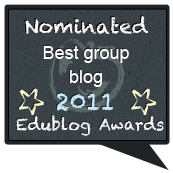Cross posted at tashacowdy.com
In our classroom area we have several different globes, a large world map and a big book atlas. We refer to these regularly during day to day discussions about story settings, current affairs, absent family and friends and, increasingly, our class on-line learning network.
Recently I have observed groups of children crowded around the globe, looking for countries to which they have a personal connection. Trenton tells a group of children that he was born in Seattle and reminds them that Ryan was moving to Seattle before he moved to Ireland. Walter moved from Denmark. Hal has visited Hawaii. So has Leander. Maya’s grandparents visited from Canada. That’s where our KinderPals are from. Daan is trying to find where his last school was, but he can’t remember the name (Quatar). Soon he is moving again to India. The children are interested to find India and see how close it is to the equator. Nikhil is worried Daan will be too hot. The conversation goes on and on, carrying over days.
I introduced the children to Google Earth earlier in the year as a tool for finding out more about our KinderPals in Canada. At the time we were conducting a class inquiry into how we share the limited resource of space. Through Google Earth the children were able to see how much more densely populated our school neighborhood in Yokohama, Japan is compared to KinderPals in BC, Canada. Since then the children haven’t shown a particular interest in exploring Google Earth further. However, as I listen to the reoccurring conversations over the last few weeks, it occurs to me that the app might help support and extend the children’s current, unplanned inquiry into where on the earth they are.
I wonder what provocation I can offer the children. Earlier in the year we read a booked called Lulie the Iceberg written by Princess Hisako Takamodo of Japan and illustrated by Warabe Aska. The story tells of the adventures of a young iceberg that breaks off the Greenland ice sheet and follows the oceans’ currents across the equator all the way to the antarctic. (Hence Nikhil’s concern about India’s proximity to the equator.) The children were enchanted by the story which I read aloud in daily installments over two weeks. We could have finished the story more quickly but the children were fascinated by the characters and plot and had many text-to-text, text-to-self and text-to-world connections they wanted to share as the story unfolded.
It occurs to me that this perhaps this book, to which the children have made such strong connections, might provide a structure to the children’s spontaneous inquiry. I invite the children to see if they can find the poles on Google Earth and then trace Lulie’s journey. I hope that the poles will provide an easy reference point as the children experiment with the orientation and zoom features on the the Google Earth app. I expect that not all children will want to conduct their inquiry using the iPads and I provide a selection of globes, atlases and a large world map. Then I sit back and watch, ready to support if needed, but otherwise letting the children explore and find out by themselves.
Some children are absorbed in the landscape of our planet, noting the frozen poles, commenting on the amount of water and discovering mountainous areas.
Others are more interested in finding countries that have a personal significance for them. Someone discovers the street view function and the children marvel at the detail.
Yet others are absorbed in looking at an atlas.
A few children decide to record their ideas on paper. I am fascinated by their careful, intricate drawings.
The children collaborate and work together, switching between the iPad app, globes, map and atlas. They share findings, dispute ideas, test theories and co-construct their understandings, revising their schemas in the light of new information.
It’s time to pack up. As the children tidy, a snippet of conversation floats over to me:
- Trenton We did a whole earth inquiry!
- Hal Now we know everything about the earth!
- Nikhil But we can still learn more.
- Daan Yeah, we can always learn more.












Oh yes indeed! We can ALWAYS learn more. You should be happy to hear those kinds of snippets of conversation. Long may it continue!
LikeLike
I agree, Linda, long may it continue! Children are such natural inquirers if only we give them the space and the time.
LikeLike
Well said, Daan, well said.
LikeLike